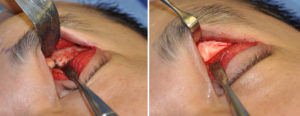Background: The forehead is not infrequently exposed to traumatic forces. If significant enough forces are applied bone fractures can occur causing a variety of forehead indentation deformities. These most commonly occur near the brow bone area since this is the ledge of the forehead where the bone is not as thick as up near the hairline.
Most traumatic forehead indentation deformities are not treated like a typical skull fracture. Fracture elevation and realignment of the bone segments are not usually done. Rather a contouring approach is used to fill in the indentation and bring the level of the depressed bone segments up to that of the surrounding forehead.
The best skull contouring material is bone cement, specifically hydroxyapatite bone cement. It is costly but its inorganic hydroxyapatite composition is the closest synthetic material to that of bone. It is ideal for the forehead and brow bone due to its exposure on the non-hair bearing bone surfaces. (minus the eyebrows) The key in its use is the necessary incisional exposure to place and shape it properly.
Case Study: This young male sustained blunt trauma to his left brow bone and forehead resulting in a depressed fracture when he was young. It was never treated primarily and went on to heal with a visible depression most seen in a vertical direction across the brow bone.

Brow bone reconstruction can be done through an upper eyelid incision of it involves the outer half or tail of the brow bone. This limited approach requires a learned skill in how to work with the unique working properties of hydroxyapatite cements which are stressed in areas of limited visibility.
Highlights:
1) Traumatic forehead contour deformities can be treated by the only application of hydroxyapatite bone cements.
2) Certain brow bone deformities can be treated through an upper eyelid or transpalpebral incisional approach.
3) The transpalpebral approach for small brow bone augmentations, when possible, spares a longer scalp incision.
Dr. Barry Eppley
Indianapolis, Indiana



